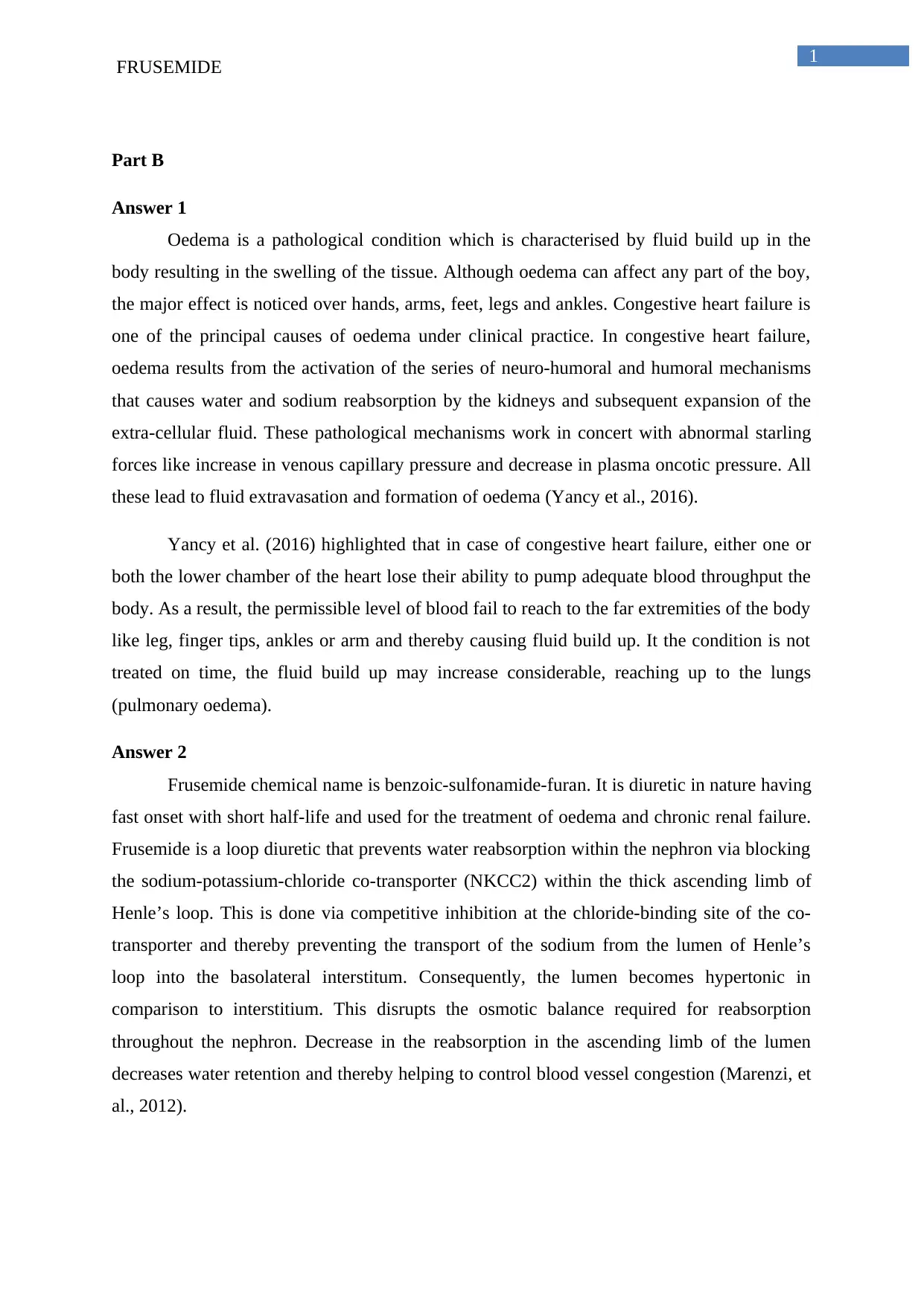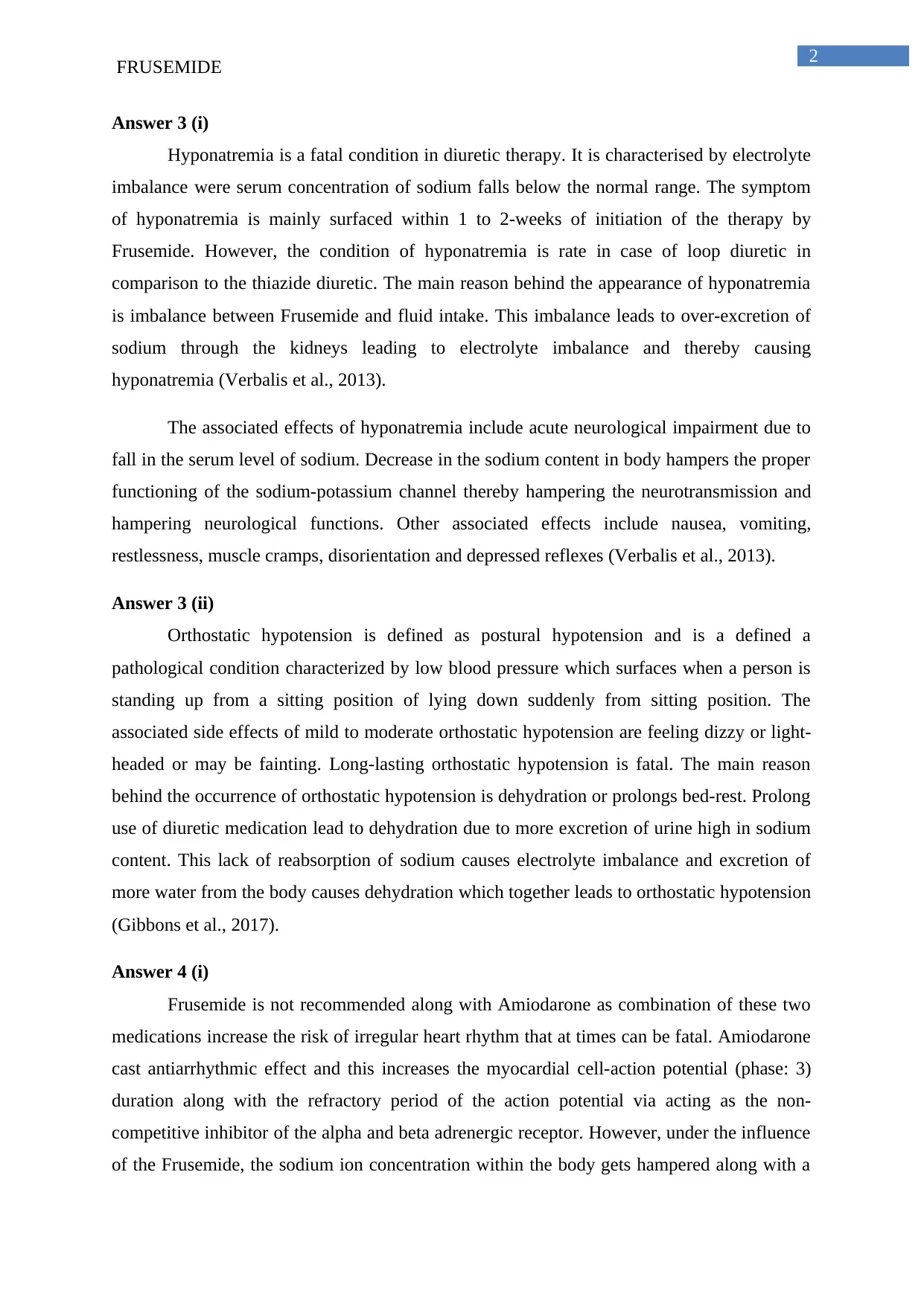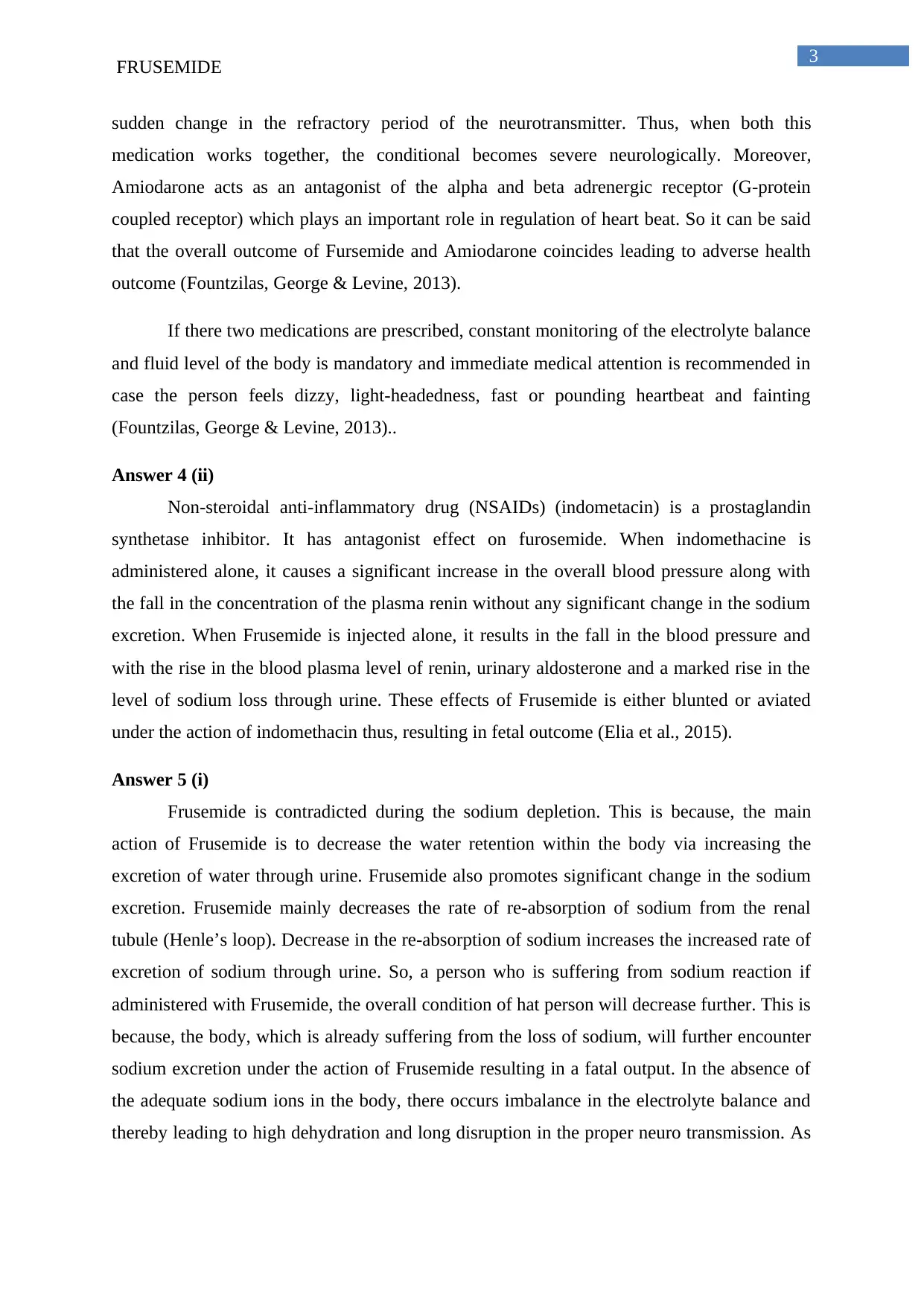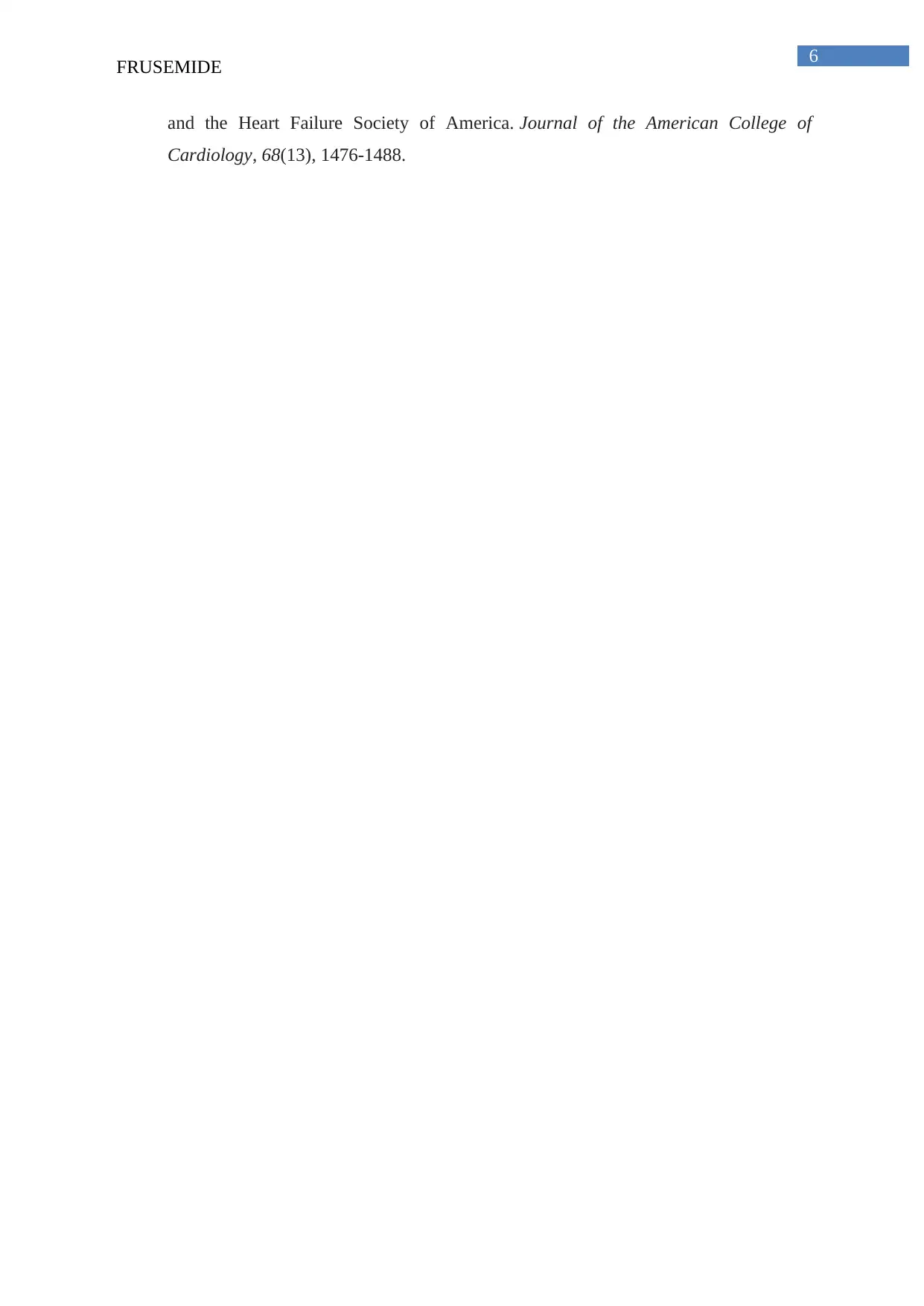Frusemide: Mechanism of Action, Side Effects and Contraindications
VerifiedAdded on 2023/06/09
|7
|2049
|251
AI Summary
This article discusses the mechanism of action, side effects and contraindications of Frusemide, a loop diuretic used for the treatment of oedema and chronic renal failure. It explains the risks associated with its use in combination with other medications and in patients with sodium and fluid depletion.
Contribute Materials
Your contribution can guide someone’s learning journey. Share your
documents today.

Running head: FRUSEMIDE
FRUSEMIDE
Name of the Student
Name of the University
Author Note
FRUSEMIDE
Name of the Student
Name of the University
Author Note
Secure Best Marks with AI Grader
Need help grading? Try our AI Grader for instant feedback on your assignments.

1
FRUSEMIDE
Part B
Answer 1
Oedema is a pathological condition which is characterised by fluid build up in the
body resulting in the swelling of the tissue. Although oedema can affect any part of the boy,
the major effect is noticed over hands, arms, feet, legs and ankles. Congestive heart failure is
one of the principal causes of oedema under clinical practice. In congestive heart failure,
oedema results from the activation of the series of neuro-humoral and humoral mechanisms
that causes water and sodium reabsorption by the kidneys and subsequent expansion of the
extra-cellular fluid. These pathological mechanisms work in concert with abnormal starling
forces like increase in venous capillary pressure and decrease in plasma oncotic pressure. All
these lead to fluid extravasation and formation of oedema (Yancy et al., 2016).
Yancy et al. (2016) highlighted that in case of congestive heart failure, either one or
both the lower chamber of the heart lose their ability to pump adequate blood throughput the
body. As a result, the permissible level of blood fail to reach to the far extremities of the body
like leg, finger tips, ankles or arm and thereby causing fluid build up. It the condition is not
treated on time, the fluid build up may increase considerable, reaching up to the lungs
(pulmonary oedema).
Answer 2
Frusemide chemical name is benzoic-sulfonamide-furan. It is diuretic in nature having
fast onset with short half-life and used for the treatment of oedema and chronic renal failure.
Frusemide is a loop diuretic that prevents water reabsorption within the nephron via blocking
the sodium-potassium-chloride co-transporter (NKCC2) within the thick ascending limb of
Henle’s loop. This is done via competitive inhibition at the chloride-binding site of the co-
transporter and thereby preventing the transport of the sodium from the lumen of Henle’s
loop into the basolateral interstitum. Consequently, the lumen becomes hypertonic in
comparison to interstitium. This disrupts the osmotic balance required for reabsorption
throughout the nephron. Decrease in the reabsorption in the ascending limb of the lumen
decreases water retention and thereby helping to control blood vessel congestion (Marenzi, et
al., 2012).
FRUSEMIDE
Part B
Answer 1
Oedema is a pathological condition which is characterised by fluid build up in the
body resulting in the swelling of the tissue. Although oedema can affect any part of the boy,
the major effect is noticed over hands, arms, feet, legs and ankles. Congestive heart failure is
one of the principal causes of oedema under clinical practice. In congestive heart failure,
oedema results from the activation of the series of neuro-humoral and humoral mechanisms
that causes water and sodium reabsorption by the kidneys and subsequent expansion of the
extra-cellular fluid. These pathological mechanisms work in concert with abnormal starling
forces like increase in venous capillary pressure and decrease in plasma oncotic pressure. All
these lead to fluid extravasation and formation of oedema (Yancy et al., 2016).
Yancy et al. (2016) highlighted that in case of congestive heart failure, either one or
both the lower chamber of the heart lose their ability to pump adequate blood throughput the
body. As a result, the permissible level of blood fail to reach to the far extremities of the body
like leg, finger tips, ankles or arm and thereby causing fluid build up. It the condition is not
treated on time, the fluid build up may increase considerable, reaching up to the lungs
(pulmonary oedema).
Answer 2
Frusemide chemical name is benzoic-sulfonamide-furan. It is diuretic in nature having
fast onset with short half-life and used for the treatment of oedema and chronic renal failure.
Frusemide is a loop diuretic that prevents water reabsorption within the nephron via blocking
the sodium-potassium-chloride co-transporter (NKCC2) within the thick ascending limb of
Henle’s loop. This is done via competitive inhibition at the chloride-binding site of the co-
transporter and thereby preventing the transport of the sodium from the lumen of Henle’s
loop into the basolateral interstitum. Consequently, the lumen becomes hypertonic in
comparison to interstitium. This disrupts the osmotic balance required for reabsorption
throughout the nephron. Decrease in the reabsorption in the ascending limb of the lumen
decreases water retention and thereby helping to control blood vessel congestion (Marenzi, et
al., 2012).

2
FRUSEMIDE
Answer 3 (i)
Hyponatremia is a fatal condition in diuretic therapy. It is characterised by electrolyte
imbalance were serum concentration of sodium falls below the normal range. The symptom
of hyponatremia is mainly surfaced within 1 to 2-weeks of initiation of the therapy by
Frusemide. However, the condition of hyponatremia is rate in case of loop diuretic in
comparison to the thiazide diuretic. The main reason behind the appearance of hyponatremia
is imbalance between Frusemide and fluid intake. This imbalance leads to over-excretion of
sodium through the kidneys leading to electrolyte imbalance and thereby causing
hyponatremia (Verbalis et al., 2013).
The associated effects of hyponatremia include acute neurological impairment due to
fall in the serum level of sodium. Decrease in the sodium content in body hampers the proper
functioning of the sodium-potassium channel thereby hampering the neurotransmission and
hampering neurological functions. Other associated effects include nausea, vomiting,
restlessness, muscle cramps, disorientation and depressed reflexes (Verbalis et al., 2013).
Answer 3 (ii)
Orthostatic hypotension is defined as postural hypotension and is a defined a
pathological condition characterized by low blood pressure which surfaces when a person is
standing up from a sitting position of lying down suddenly from sitting position. The
associated side effects of mild to moderate orthostatic hypotension are feeling dizzy or light-
headed or may be fainting. Long-lasting orthostatic hypotension is fatal. The main reason
behind the occurrence of orthostatic hypotension is dehydration or prolongs bed-rest. Prolong
use of diuretic medication lead to dehydration due to more excretion of urine high in sodium
content. This lack of reabsorption of sodium causes electrolyte imbalance and excretion of
more water from the body causes dehydration which together leads to orthostatic hypotension
(Gibbons et al., 2017).
Answer 4 (i)
Frusemide is not recommended along with Amiodarone as combination of these two
medications increase the risk of irregular heart rhythm that at times can be fatal. Amiodarone
cast antiarrhythmic effect and this increases the myocardial cell-action potential (phase: 3)
duration along with the refractory period of the action potential via acting as the non-
competitive inhibitor of the alpha and beta adrenergic receptor. However, under the influence
of the Frusemide, the sodium ion concentration within the body gets hampered along with a
FRUSEMIDE
Answer 3 (i)
Hyponatremia is a fatal condition in diuretic therapy. It is characterised by electrolyte
imbalance were serum concentration of sodium falls below the normal range. The symptom
of hyponatremia is mainly surfaced within 1 to 2-weeks of initiation of the therapy by
Frusemide. However, the condition of hyponatremia is rate in case of loop diuretic in
comparison to the thiazide diuretic. The main reason behind the appearance of hyponatremia
is imbalance between Frusemide and fluid intake. This imbalance leads to over-excretion of
sodium through the kidneys leading to electrolyte imbalance and thereby causing
hyponatremia (Verbalis et al., 2013).
The associated effects of hyponatremia include acute neurological impairment due to
fall in the serum level of sodium. Decrease in the sodium content in body hampers the proper
functioning of the sodium-potassium channel thereby hampering the neurotransmission and
hampering neurological functions. Other associated effects include nausea, vomiting,
restlessness, muscle cramps, disorientation and depressed reflexes (Verbalis et al., 2013).
Answer 3 (ii)
Orthostatic hypotension is defined as postural hypotension and is a defined a
pathological condition characterized by low blood pressure which surfaces when a person is
standing up from a sitting position of lying down suddenly from sitting position. The
associated side effects of mild to moderate orthostatic hypotension are feeling dizzy or light-
headed or may be fainting. Long-lasting orthostatic hypotension is fatal. The main reason
behind the occurrence of orthostatic hypotension is dehydration or prolongs bed-rest. Prolong
use of diuretic medication lead to dehydration due to more excretion of urine high in sodium
content. This lack of reabsorption of sodium causes electrolyte imbalance and excretion of
more water from the body causes dehydration which together leads to orthostatic hypotension
(Gibbons et al., 2017).
Answer 4 (i)
Frusemide is not recommended along with Amiodarone as combination of these two
medications increase the risk of irregular heart rhythm that at times can be fatal. Amiodarone
cast antiarrhythmic effect and this increases the myocardial cell-action potential (phase: 3)
duration along with the refractory period of the action potential via acting as the non-
competitive inhibitor of the alpha and beta adrenergic receptor. However, under the influence
of the Frusemide, the sodium ion concentration within the body gets hampered along with a

3
FRUSEMIDE
sudden change in the refractory period of the neurotransmitter. Thus, when both this
medication works together, the conditional becomes severe neurologically. Moreover,
Amiodarone acts as an antagonist of the alpha and beta adrenergic receptor (G-protein
coupled receptor) which plays an important role in regulation of heart beat. So it can be said
that the overall outcome of Fursemide and Amiodarone coincides leading to adverse health
outcome (Fountzilas, George & Levine, 2013).
If there two medications are prescribed, constant monitoring of the electrolyte balance
and fluid level of the body is mandatory and immediate medical attention is recommended in
case the person feels dizzy, light-headedness, fast or pounding heartbeat and fainting
(Fountzilas, George & Levine, 2013)..
Answer 4 (ii)
Non-steroidal anti-inflammatory drug (NSAIDs) (indometacin) is a prostaglandin
synthetase inhibitor. It has antagonist effect on furosemide. When indomethacine is
administered alone, it causes a significant increase in the overall blood pressure along with
the fall in the concentration of the plasma renin without any significant change in the sodium
excretion. When Frusemide is injected alone, it results in the fall in the blood pressure and
with the rise in the blood plasma level of renin, urinary aldosterone and a marked rise in the
level of sodium loss through urine. These effects of Frusemide is either blunted or aviated
under the action of indomethacin thus, resulting in fetal outcome (Elia et al., 2015).
Answer 5 (i)
Frusemide is contradicted during the sodium depletion. This is because, the main
action of Frusemide is to decrease the water retention within the body via increasing the
excretion of water through urine. Frusemide also promotes significant change in the sodium
excretion. Frusemide mainly decreases the rate of re-absorption of sodium from the renal
tubule (Henle’s loop). Decrease in the re-absorption of sodium increases the increased rate of
excretion of sodium through urine. So, a person who is suffering from sodium reaction if
administered with Frusemide, the overall condition of hat person will decrease further. This is
because, the body, which is already suffering from the loss of sodium, will further encounter
sodium excretion under the action of Frusemide resulting in a fatal output. In the absence of
the adequate sodium ions in the body, there occurs imbalance in the electrolyte balance and
thereby leading to high dehydration and long disruption in the proper neuro transmission. As
FRUSEMIDE
sudden change in the refractory period of the neurotransmitter. Thus, when both this
medication works together, the conditional becomes severe neurologically. Moreover,
Amiodarone acts as an antagonist of the alpha and beta adrenergic receptor (G-protein
coupled receptor) which plays an important role in regulation of heart beat. So it can be said
that the overall outcome of Fursemide and Amiodarone coincides leading to adverse health
outcome (Fountzilas, George & Levine, 2013).
If there two medications are prescribed, constant monitoring of the electrolyte balance
and fluid level of the body is mandatory and immediate medical attention is recommended in
case the person feels dizzy, light-headedness, fast or pounding heartbeat and fainting
(Fountzilas, George & Levine, 2013)..
Answer 4 (ii)
Non-steroidal anti-inflammatory drug (NSAIDs) (indometacin) is a prostaglandin
synthetase inhibitor. It has antagonist effect on furosemide. When indomethacine is
administered alone, it causes a significant increase in the overall blood pressure along with
the fall in the concentration of the plasma renin without any significant change in the sodium
excretion. When Frusemide is injected alone, it results in the fall in the blood pressure and
with the rise in the blood plasma level of renin, urinary aldosterone and a marked rise in the
level of sodium loss through urine. These effects of Frusemide is either blunted or aviated
under the action of indomethacin thus, resulting in fetal outcome (Elia et al., 2015).
Answer 5 (i)
Frusemide is contradicted during the sodium depletion. This is because, the main
action of Frusemide is to decrease the water retention within the body via increasing the
excretion of water through urine. Frusemide also promotes significant change in the sodium
excretion. Frusemide mainly decreases the rate of re-absorption of sodium from the renal
tubule (Henle’s loop). Decrease in the re-absorption of sodium increases the increased rate of
excretion of sodium through urine. So, a person who is suffering from sodium reaction if
administered with Frusemide, the overall condition of hat person will decrease further. This is
because, the body, which is already suffering from the loss of sodium, will further encounter
sodium excretion under the action of Frusemide resulting in a fatal output. In the absence of
the adequate sodium ions in the body, there occurs imbalance in the electrolyte balance and
thereby leading to high dehydration and long disruption in the proper neuro transmission. As
Secure Best Marks with AI Grader
Need help grading? Try our AI Grader for instant feedback on your assignments.

4
FRUSEMIDE
a result, the person will feel dis-oriented, restless, and will suffer from nausea and at times
might faint (Na, Morris & Johnson, 2012).
Answer 5 (ii)
Frusemide is not recommended during fluid depletion because frusemide is basically
a diuretics and a derivative of anthranilic acid. It works via increasing the overall amount of
urine output and thereby helping to remove excess amount of water (Oedema). It is
insoluable and inhibits the reabsorption of sodium and chloride from promixal convoluted
tubule, distal convoluted tubule and loop of Henle. Its high degree of efficiacy is mainly due
to its unique site of action. Thus, it can be sad that under the action of Frusemide, the extra
water of the unwanted water of the body which is causing the water retention os being
removed via urine. However, when a person is suffering from fluid depletion, means lack of
adequate water content in the body, the administration of Frusemide is not permissible. This
is because, Frusemide itself causes water depletion. Hence when administered to the patient
with fluid depletion, it will cause more loss of the water from the body. Loss of water from
the body will cause severe dehydration leading to the development of nausea, headache, dry
skin and dizziness, light-headedness, muscle cramps and overall weakness in the body. This
will eventually lead to death (Lu et al., 2012).
FRUSEMIDE
a result, the person will feel dis-oriented, restless, and will suffer from nausea and at times
might faint (Na, Morris & Johnson, 2012).
Answer 5 (ii)
Frusemide is not recommended during fluid depletion because frusemide is basically
a diuretics and a derivative of anthranilic acid. It works via increasing the overall amount of
urine output and thereby helping to remove excess amount of water (Oedema). It is
insoluable and inhibits the reabsorption of sodium and chloride from promixal convoluted
tubule, distal convoluted tubule and loop of Henle. Its high degree of efficiacy is mainly due
to its unique site of action. Thus, it can be sad that under the action of Frusemide, the extra
water of the unwanted water of the body which is causing the water retention os being
removed via urine. However, when a person is suffering from fluid depletion, means lack of
adequate water content in the body, the administration of Frusemide is not permissible. This
is because, Frusemide itself causes water depletion. Hence when administered to the patient
with fluid depletion, it will cause more loss of the water from the body. Loss of water from
the body will cause severe dehydration leading to the development of nausea, headache, dry
skin and dizziness, light-headedness, muscle cramps and overall weakness in the body. This
will eventually lead to death (Lu et al., 2012).

5
FRUSEMIDE
References
Elia, C., Graupera, I., Barreto, R., Solà, E., Moreira, R., Huelin, P., ... & Fabrellas, N. (2015).
Severe acute kidney injury associated with non-steroidal anti-inflammatory drugs in
cirrhosis: A case-control study. Journal of hepatology, 63(3), 593-600.
Fountzilas, C., George, J., & Levine, R. (2013). Dabigatran overdose secondary to acute
kidney injury and amiodarone use. NZ Med J, 126(1370), 110-2.
Gibbons, C. H., Schmidt, P., Biaggioni, I., Frazier-Mills, C., Freeman, R., Isaacson, S., ... &
Mehdirad, A. (2017). The recommendations of a consensus panel for the screening,
diagnosis, and treatment of neurogenic orthostatic hypotension and associated supine
hypertension. Journal of neurology, 264(8), 1567-1582.
Lu, B., Yan, J., Yang, X., Li, J., & Chen, K. (2012). Involvement of brain ANG II in acute
sodium depletion induced salty taste changes. Regulatory peptides, 179(1-3), 15-22.
Marenzi, G., Ferrari, C., Marana, I., Assanelli, E., De Metrio, M., Teruzzi, G., ... & Bartorelli,
A. L. (2012). Prevention of contrast nephropathy by furosemide with matched
hydration: the MYTHOS (induced diuresis with matched hydration compared to
standard hydration for contrast induced nephropathy prevention) trial. JACC:
Cardiovascular Interventions, 5(1), 90-97.
Na, E. S., Morris, M. J., & Johnson, A. K. (2012). Opioid mechanisms that mediate the
palatability of and appetite for salt in sodium replete and deficient states. Physiology
& behavior, 106(2), 164-170.
Verbalis, J. G., Goldsmith, S. R., Greenberg, A., Korzelius, C., Schrier, R. W., Sterns, R. H.,
& Thompson, C. J. (2013). Diagnosis, evaluation, and treatment of hyponatremia:
expert panel recommendations. The American journal of medicine, 126(10), S1-S42.
Yancy, C. W., Jessup, M., Bozkurt, B., Butler, J., Casey, D. E., Colvin, M. M., ... &
Hollenberg, S. M. (2016). 2016 ACC/AHA/HFSA focused update on new
pharmacological therapy for heart failure: an update of the 2013 ACCF/AHA
guideline for the management of heart failure: a report of the American College of
Cardiology/American Heart Association Task Force on Clinical Practice Guidelines
FRUSEMIDE
References
Elia, C., Graupera, I., Barreto, R., Solà, E., Moreira, R., Huelin, P., ... & Fabrellas, N. (2015).
Severe acute kidney injury associated with non-steroidal anti-inflammatory drugs in
cirrhosis: A case-control study. Journal of hepatology, 63(3), 593-600.
Fountzilas, C., George, J., & Levine, R. (2013). Dabigatran overdose secondary to acute
kidney injury and amiodarone use. NZ Med J, 126(1370), 110-2.
Gibbons, C. H., Schmidt, P., Biaggioni, I., Frazier-Mills, C., Freeman, R., Isaacson, S., ... &
Mehdirad, A. (2017). The recommendations of a consensus panel for the screening,
diagnosis, and treatment of neurogenic orthostatic hypotension and associated supine
hypertension. Journal of neurology, 264(8), 1567-1582.
Lu, B., Yan, J., Yang, X., Li, J., & Chen, K. (2012). Involvement of brain ANG II in acute
sodium depletion induced salty taste changes. Regulatory peptides, 179(1-3), 15-22.
Marenzi, G., Ferrari, C., Marana, I., Assanelli, E., De Metrio, M., Teruzzi, G., ... & Bartorelli,
A. L. (2012). Prevention of contrast nephropathy by furosemide with matched
hydration: the MYTHOS (induced diuresis with matched hydration compared to
standard hydration for contrast induced nephropathy prevention) trial. JACC:
Cardiovascular Interventions, 5(1), 90-97.
Na, E. S., Morris, M. J., & Johnson, A. K. (2012). Opioid mechanisms that mediate the
palatability of and appetite for salt in sodium replete and deficient states. Physiology
& behavior, 106(2), 164-170.
Verbalis, J. G., Goldsmith, S. R., Greenberg, A., Korzelius, C., Schrier, R. W., Sterns, R. H.,
& Thompson, C. J. (2013). Diagnosis, evaluation, and treatment of hyponatremia:
expert panel recommendations. The American journal of medicine, 126(10), S1-S42.
Yancy, C. W., Jessup, M., Bozkurt, B., Butler, J., Casey, D. E., Colvin, M. M., ... &
Hollenberg, S. M. (2016). 2016 ACC/AHA/HFSA focused update on new
pharmacological therapy for heart failure: an update of the 2013 ACCF/AHA
guideline for the management of heart failure: a report of the American College of
Cardiology/American Heart Association Task Force on Clinical Practice Guidelines

6
FRUSEMIDE
and the Heart Failure Society of America. Journal of the American College of
Cardiology, 68(13), 1476-1488.
FRUSEMIDE
and the Heart Failure Society of America. Journal of the American College of
Cardiology, 68(13), 1476-1488.
1 out of 7
Your All-in-One AI-Powered Toolkit for Academic Success.
+13062052269
info@desklib.com
Available 24*7 on WhatsApp / Email
![[object Object]](/_next/static/media/star-bottom.7253800d.svg)
Unlock your academic potential
© 2024 | Zucol Services PVT LTD | All rights reserved.



